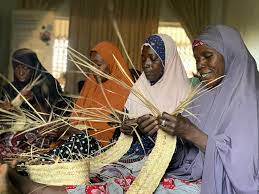
Agriculture plays a vital role in Nigeria's economy, with numerous opportunities for profitable ventures. One such opportunity is waterleaf farming, a high-demand leafy vegetable known for its rich nutritional content and culinary versatility.
Waterleaf (Talinum triangulare) is a highly nutritious leafy vegetable commonly consumed in Nigeria and other African countries. It thrives in a tropical climate and is known for its succulent leaves, high water content, and rich nutritional composition, including vitamins A, C, and E, iron, calcium, and antioxidants.
Nutritional Benefits of waterleaf
- Preparing waterleaf in combination with avocado and alligator pepper can be used to treat hypertension
- Regular consumption of waterleaf can delay the onset of stroke and heart diseases, especially among the older population
- Waterleaf is loaded with crude protein (22.1%) ash (33.98%) and crude fibre
- A leaf of waterleaf is a rich source of lipids, vitamins and protein. It has as much protein as cowpea, millet, cashew nuts and peanuts
- The plant exhibits a whole range of pharmacological and biological activities such as anti-fungal, anti-bacterial and anti-inflammatory properties
- While it serves some medicinal purposes for humans, it also acts as green forage for management of rabbit feed.
With its increasing popularity and demand, starting a waterleaf farming business can be a lucrative venture. This article aims to provide a comprehensive guide on how to start a successful waterleaf farming business in Nigeria, covering various aspects such as land preparation, cultivation techniques, marketing strategies, and potential challenges.
Conducting Market Research: Before venturing into any agricultural business, it is essential to conduct thorough market research. Identify the demand for waterleaf in your target market, study existing suppliers, and evaluate potential competition. This will help you determine the viability of your business and make informed decisions.
Acquiring Suitable Land: Waterleaf thrives in well-drained, loamy soil with a pH range of 6.0 to 6.8. Look for a suitable piece of land with these characteristics. Waterleaf plant thrives well in a rich soil that has good moisture. The size of the land will depend on your planned scale of operation, but a minimum of half an acre is recommended for commercial purposes.
Land Preparation: Clear the land of any weeds, debris, or unwanted vegetation. Plow or till the soil to a depth of about 20 centimeters to improve its texture and promote aeration.
Make beds about 5m by 2m in size or according to your desire and also as you can manage. Put walking distance between beds so as to walk about freely without matching the waterleaf. Make the beds by tilling the soil and raising it to some level. Soils that are raised have been found to do better than the ones on plain ground. The tilling of soil will help in aeration and weed control.
Mix poultry dung with soil and water and spread them on the bed this will help in enriching the soil and also conserve moisture.
Seed Selection and Planting: Waterleaf can be planted through seed or stem. You have to select healthy and quality waterleaf seed or stem to be planted on your farm. Make sure you purchase or select them from a trusted source.
For the stem, however, cut them into 3-5 inches and plant in clusters. Endeavour to be careful while inserting them into the soil.
Sow the seeds directly into the prepared seedbeds or nursery trays. Waterleaf seeds are small and should be planted at a depth of approximately 1 centimeter. Ensure adequate spacing between the rows and maintain a distance of 10 to 15 centimeters between the plants.
Irrigation and Water Management: Waterleaf requires regular watering, especially during dry periods. Adequate moisture is crucial for its growth and leaf production. Implement an efficient irrigation system such as drip irrigation or sprinklers to ensure uniform water distribution. Avoid waterlogging, as it can lead to root rot and other diseases.
Fertilization and Soil Management: Conduct a soil test to determine the nutrient composition and pH level of your soil. Based on the results, apply appropriate fertilizers and organic supplements to meet the crop's nutritional requirements. Regularly monitor soil fertility and adjust fertilizer applications accordingly.
Pest and Disease Control: Waterleaf is susceptible to pests and diseases such as aphids, leaf miners, and powdery mildew.
Common Pests in Waterleaf Farming
Aphids (Aphidoidea): Aphids are tiny sap-sucking insects that can quickly multiply and infest waterleaf plants. They cause stunted growth, curling of leaves, and the presence of sticky honeydew on the foliage. Regular scouting and the use of organic insecticides like neem oil can help control aphid populations.
Leaf miners (Liriomyza spp.): Leaf miners are small flies whose larvae burrow through the leaf tissue, leaving visible trails or mines. This feeding damage weakens the plants and reduces their photosynthetic capacity. Regularly removing infested leaves and the use of yellow sticky traps can help manage leaf miner populations.
Spider mites (Tetranychus spp.): Spider mites are tiny arachnids that feed on waterleaf plants, causing yellowing, stippling, and webbing on the leaves. They thrive in dry and dusty conditions. Maintaining adequate humidity levels, practicing proper irrigation, and using insecticidal soaps or oils can help control spider mite infestations.
Cutworms (Agrotis spp.): Cutworms are caterpillars that hide in the soil during the day and emerge at night to feed on the stems of waterleaf plants near the soil surface. Applying physical barriers, such as collars or cardboard rings around the base of the plants, can prevent cutworm damage. Biological control agents like Steinernema feltiae, a beneficial nematode, can also be used to target cutworms.
Common Diseases in Waterleaf Farming
Downy mildew (Peronospora talini): Downy mildew is a fungal disease that affects waterleaf plants, causing yellowish or whitish patches on the upper leaf surface and a fuzzy, purplish-gray growth on the lower surface. To manage downy mildew, ensure proper plant spacing for adequate air circulation, avoid overhead irrigation, and apply copper-based fungicides as preventive measures.
Leaf spot (Alternaria spp.): Leaf spot is a common fungal disease characterized by circular, dark brown or black spots with yellow halos on waterleaf leaves. It thrives in warm and humid conditions. Practice crop rotation, remove infected plant debris, and apply fungicides containing mancozeb or copper oxychloride to manage leaf spot.
Powdery mildew (Erysiphe cichoracearum): Powdery mildew appears as a white powdery coating on waterleaf leaves, stems, and flowers. It can cause leaf distortion, reduced photosynthesis, and premature leaf drop. Maintaining proper spacing, providing good air circulation, and using sulfur-based fungicides can help control powdery mildew.
Bacterial leaf blight (Xanthomonas campestris pv. talini): Bacterial leaf blight is a destructive disease that causes water-soaked lesions on the leaves, which later turn brown and papery. It spreads rapidly in wet conditions. Avoid overhead irrigation, remove and destroy infected plants, and apply copper-based bactericides to manage bacterial leaf blight.
Integrated Pest and Disease Management (IPDM) Strategies
Crop rotation: Rotate waterleaf crops with unrelated plants to break pest and disease cycles.
Sanitation: Remove and destroy infected plant material to prevent the spread of pests and diseases.
Proper irrigation: Avoid overwatering or overhead irrigation to minimize favorable conditions for diseases.
Beneficial insects: Encourage beneficial insects like ladybugs and lacewings, which prey on pests, by providing suitable habitats and minimizing the use of broad-spectrum insecticides.
Organic pesticides: Utilize organic pesticides and botanical extracts, such as neem oil or pyrethrin, as part of an IPDM approach.
Monitoring and scouting: Regularly inspect waterleaf crops for signs of pests and diseases to implement timely interventions.
Harvesting and Post-Harvest Handling: Waterleaf is typically ready for harvest within 6 to 8 weeks after planting. Harvest the leaves when they are tender and have reached a desirable size, typically around 15 to 20 centimeters in length. Use sharp, clean scissors or knives to cut the leaves, taking care not to damage the plant. Proper post-harvest handling, including washing, sorting, and packaging, is crucial to maintain the quality and extend the shelf life of the produce.
Marketing and Distribution: Develop a marketing strategy to sell your waterleaf produce. Establish connections with local markets, restaurants, supermarkets, and vegetable vendors. Consider setting up your own stall at farmers' markets or explore online platforms for direct sales. Build a reputation for supplying high-quality waterleaf consistently, and consider value-addition options such as packaging or processing to diversify your product range.
Potential Challenges: Waterleaf farming may face challenges such as unpredictable weather conditions, pest and disease outbreaks, market fluctuations, and limited access to finance or technical support. Stay updated with modern farming practices, network with fellow farmers, and seek assistance from agricultural extension services or relevant organizations to overcome these challenges.
In conclusion, starting a waterleaf farming business in Nigeria requires careful planning, diligent execution, and continuous learning. With the increasing demand for this nutritious vegetable, a well-managed waterleaf farm has the potential to yield significant profits.
Follow the steps outlined in this guide, adapt them to your specific circumstances, and embark on your journey towards a successful waterleaf farming business in Nigeria.






















